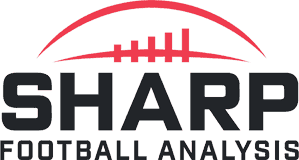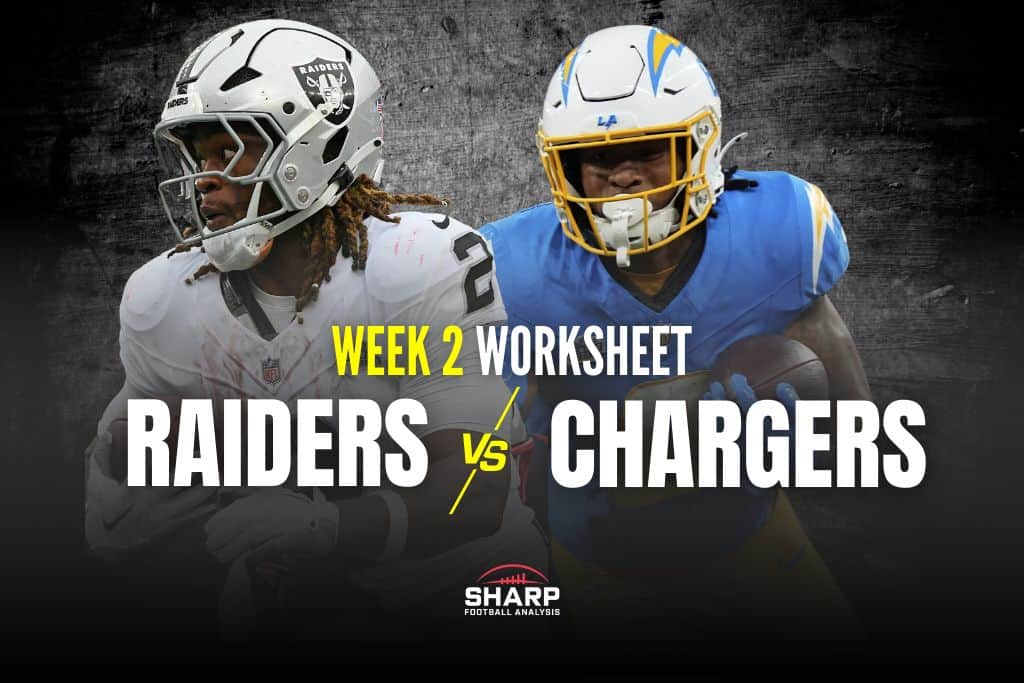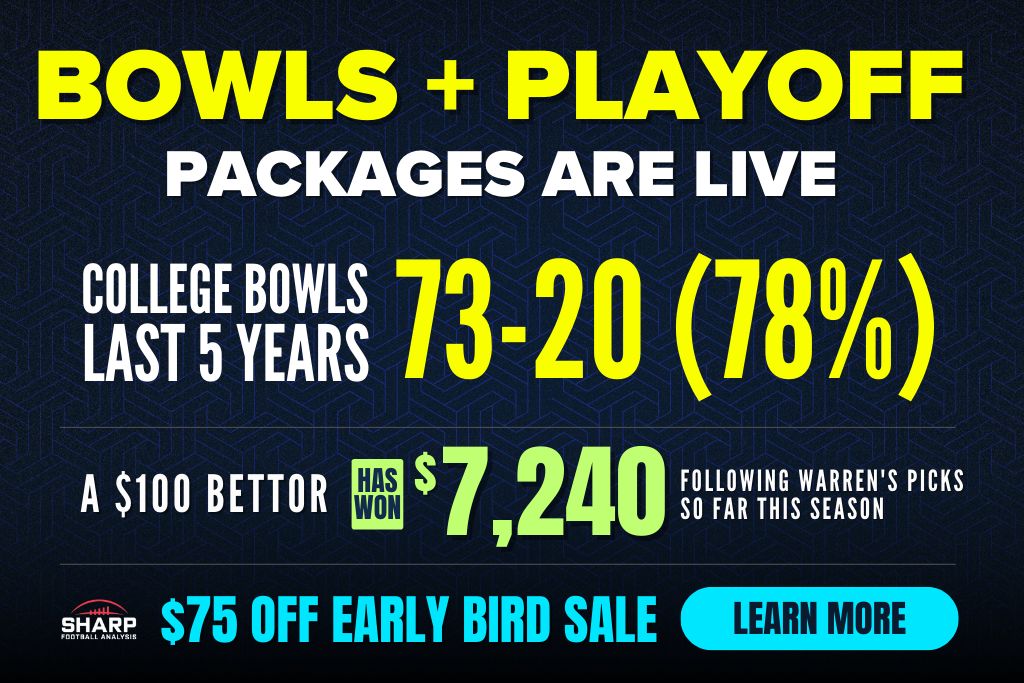The Worksheet, a comprehensive fantasy football preview by Rich Hribar, breaks down everything you need to know about the Week 2 matchup between the Raiders and Chargers on Monday Night Football.
Find a breakdown of every Week 2 NFL game in our Worksheet Hub.
| LA Chargers | Rank | @ | Las Vegas | Rank |
|---|---|---|---|---|
| -3.5 | Spread | 3.5 | ||
| 25.3 | Implied Total | 21.75 | ||
| 27.0 | 6 | Points/Gm | 20.0 | 15 |
| 21.0 | 19 | Points All./Gm | 13.0 | 6 |
| 62.0 | 13 | Plays/Gm | 62.0 | 13 |
| 58.0 | 13 | Opp. Plays/Gm | 68.0 | 25 |
| 6.4 | 4 | Off. Yards/Play | 6.3 | 6 |
| 6 | 25 | Def. Yards/Play | 4.9 | 15 |
| 40.32% | 19 | Rush% | 38.71% | 23 |
| 59.68% | 14 | Pass% | 61.29% | 10 |
| 29.31% | 3 | Opp. Rush % | 26.47% | 2 |
| 70.69% | 30 | Opp. Pass % | 73.53% | 31 |
- The Raiders had a 72.7% dropback rate in neutral game situations in Week 1, the second-highest rate in the league.
- The Chargers had a 68.2% dropback rate in those situations, fifth in the league.
- In Week 1, 85.6% of the Las Vegas yardage was achieved through passing, the highest rate in the league.
- 14.5% of Las Vegas' plays on offense gained 20-plus yards, the second-highest rate of Week 1. They had a 5.1% rate in that department in 2024 (24th).
- The Chargers (5.9%) and Raiders (11.8%) had the lowest rate of passes at or behind the line of scrimmage in Week 1. The league average was 23.4%.
- Justin Herbert threw to his wide receivers 82.4% of the time in Week 1, the highest rate in a game for his career.
- 70.8% of Geno Smith's Week 1 completions resulted in a first down or touchdown, the highest rate in the league.
- 64% of Justin Herbert's completions resulted in a first down or touchdown, second in the league. The league average was 50.5%.
- The Chargers have averaged over 3.0 points per drive in four straight regular season games.
- Los Angeles averaged 44.9 yards per possession in Week 1, third in the league.
Trust = spike production for that player
Quarterback
Justin Herbert (TRUST): When we left off a year ago, the Chargers shifted to a pass-first offense, putting this offense in the hands of their best player.
After a tough playoff loss where Herbert threw 4 interceptions, they paid Mekhi Becton to open free agency, added Najee Harris, and used their first-round pick on Omarion Hampton.
I was wondering if that could be a signal that Jim Harbaugh and Greg Roman would want to revert to their run-first tendencies.
Nope.
The Chargers doubled down on their approach to end 2024 in the season opener.
The Chargers threw the ball 14% over expectation in Week 1, which included a rate 15% over expectation on first downs.
On their second possession of the game, the Chargers were pinned back at their two-yard line after a punt.
They then threw out of their end zone on the next two plays.
They ended up punting that drive (on a failed third-and-two run, of all things), but that was all I needed to see to convince me that they were committed to the cause.
Herbert went on to carve the Chiefs in the opener, throwing for 318 yards (9.4 yards per pass attempt) and 3 touchdowns.
Herbert rushed for a career-high 306 yards in 2024.
In Week 1, he ran 7 times for 32 yards.
After one week of football, there are not a ton of sweeping changes I would make to pre-draft ranks, but Herbert would be one of the players I would want to go back and move way up the board at the position.
This week, the Chargers get a Las Vegas secondary that I believe we still want to attack.
Perhaps I will be proven wrong as we build out our 2025 sample, since Drake Maye and the Patriots did not take full advantage.
However, this was still our lowest-ranked secondary coming into the year.
I also believe their run defense is going to be better than their pass defense, pushing some funnel for opponents to pass more against them in neutral game scripts, which is what the Chargers have shown since the midway point of last season.
The Chargers have a strong team total, and the last time these teams played, Herbert was QB3 (28 points) on the week, throwing for 346 yards and 9.6 yards per pass attempt.
Geno Smith: Smith got off to a solid start in his first start with the Raiders, throwing for 362 yards and 10.6 yards per pass attempt, both of which were second in the league.
The Raiders are another team that appears to be a pass-heavy offense and better suited to throw the ball.
This offensive line did not make a ton of changes this offseason after being one of the worst run-blocking units in the league in 2024.
The first team did not run the ball well in the preseason and did not run well in Week 1.
The Raiders were second in the NFL in neutral pass rate outside of the fourth quarter and ended Week 1 throwing the ball 8% above expectation (14% over expectation on first downs).
Smith took advantage, connecting on 9 gains of 20 or more yards.
He attempted 6 passes on throws of 20 or more yards downfield, connecting on 4 of them for 120 yards and a touchdown.
Smith still ended up as QB15 (17.5 points) since he once again faced poor touchdown luck (one touchdown pass) despite his impressive yardage.
However, he is a solid floor-based QB2 with upside to be a back-end QB1 if and when the touchdowns come along.
I prefer to use him as a QB2 out of respect for the Chargers' defense, but I would also have no issues if he were a starter in 1QB formats, as this should be a pass-heavy game environment.
After the Chargers were second in the NFL last year in allowing 6.7 yards per pass attempt, they allowed 6.6 Y/A in Week 1 against Patrick Mahomes.
Running Back
Ashton Jeanty: This game features both of the first-round running backs from this year’s draft.
Jeanty opened his NFL career as the workhorse he was in college.
He accrued 21 touches (tied for fourth among running backs) and handled 87.5% of the backfield touches (RB6).
He did get into the end zone, but the production was overall limited.
Jeanty rushed 19 times for 38 yards and caught two passes for 2 yards.
He failed to gain yardage on 42.1% of his runs, the fourth-worst rate in Week 1.
The Raiders had one of the worst rushing seasons in NFL history last year.
The backfield was not stocked with talent, but the offensive line was a significant component of that output.
They were rough this preseason.
Jeanty averaged 0.92 yards before contact per run in the preseason and hit at or behind the line on 50% of his attempts.
That carried into Week 1.
Jeanty averaged -0.32 yards before contact per rush.
Out of his 19 runs, he was hit at or behind the line of scrimmage on 15 of them.
Jeanty has the volume, but the environment needs to improve to push him beyond being a volume-based option that looks better as an RB2 than as an RB1.
It is only one week, so we will let things breathe, but we do need this offensive line to improve.
The Chargers were not challenged to defend the run last week, facing 10 running back attempts and allowing 41 yards.
Omarion Hampton: Hampton did not get off to an efficient start, either.
He turned 17 touches into 61 yards in his first game, rushing 15 times for 48 yards while catching two passes for 13 yards.
Hampton also had a high workload, however.
He handled 89.5% of the backfield touches, RB5 on the week.
There is a slight increase in fragility in Hampton’s workload, as Najee Harris was just cleared for contact in practice just days before the game.
Harris only ended up playing 11 offensive snaps, touching the ball twice for 10 yards.
I buy that Hampton is the lead back here.
I also believe that Harris will get an increase in work moving forward as a complement.
This offensive line may also be built to be better in pass protection than running the ball, but they faced a strong Kansas City run defense in Week 1, so I want to see more of this running game against other opponents.
Hampton only rushed for 0.60 yards before contact per rush in Week 1, failing to gain yards on 33.3% of his runs.
He finished 25 yards below rushing expectations in Week 1, tied for the worst in the league.
This may be a pass-first offense, but the Chargers will offer scoring opportunities for Hampton, and they are favored here to provide a game script to get him touches.
He is a volume-based RB2 for the time being.
The Raiders allowed 45 yards on 13 running back attempts (3.5 YPC) in Week 1 to the New England backfield.
Wide Receiver
Ladd McConkey: McConkey collected 6 of 9 targets for 74 yards in Week 1.
He watched the other two receivers on the team have higher-scoring fantasy nights, but McConkey was still on the field for a team-high 92.7% of the dropbacks.
We also got to see McConkey gain more diverse usage, something we were counting on with the addition of Keenan Allen.
In Week 1, McConkey’s slot rate was 48.1%, compared to a 66% rate as a rookie.
As a rookie, McConkey averaged 2.79 yards per route when he got to move out of the slot.
In Week 1, he ran 19 routes outside, averaging 3.0 yards per route.
This will give McConkey access to additional targets downfield this season.
On one of the few misses from Herbert in the opener, McConkey had a walk-in score on a double move that was overthrown.
We are loading up a WR1 campaign for McConkey.
The only potential thorn in that outcome would be touchdowns.
If there was one ounce of shade here, it was that his offense still used McConkey as a decoy in the red zone for the other receivers.
He soaked up the defense on Allen’s touchdown.
He was out targeted in the red zone by Quentin Johnston last season.
In Week 1, the other wideouts had three red zone targets while McConkey had zero.
He was out targeted by Johnston in the end zone as well last year.
In Week 1, Johnston (2), Allen (1), and KeAndre Lambert-Smith (1) had the end zone targets.
Jakobi Meyers (TRUST): Meyers picked up where he left off a year ago, grabbing 8 of 10 targets for 97 yards in Week 1.
Meyers accounted for 30.3% of the team’s targets, WR13 to open the season.
The Raiders did lower their rate of 11 personnel from their preseason rate (which was 100%), but Meyers played more slot snaps than he did a year ago.
Meyers was in the slot for 62.1% of his snaps after a 33.3% rate in 2024 and a 29.5% rate in 2023.
Like McConkey, this means that Meyers was the receiver they featured, regardless of personnel.
He was not tied to the slot in only 3WR sets.
Meyers still ran a route on 97.4% of the team’s dropbacks.
Like McConkey, the addition of snaps at another position will aid his fantasy production.
That spike in slot snaps will go a long way paired with Smith’s accuracy.
Meyers already looks like one of the best pre-draft values in what appears to be a pass-first offense with better quarterback play.
The last time these teams met, Meyers caught 9 passes for 123 yards and a touchdown.
Quentin Johnston: Johnston showed in Week 1 that he still has a significant role in this offense.
He caught 5 of 7 targets for 79 yards and 2 touchdowns in the opener.
It is rare for a Round 1 wide receiver who improved in year two and still had a strong quarterback attachment to be undesired for fantasy, but that was the case.
I even wrote that same sentence in his player profile in the Tiers, and then still undervalued him for managed leagues.
He was a best-ball target, and I believe he will still be a better player in that format since you can outright avoid the duds, but there is tangible upside here.
He was out targeted by both McConkey and Allen to keep us grounded, but the Chargers understand how to use him in space on crossers and near the end zone.
The addition of Allen was also good for Johnston, and this offense does not have to ask Johnston to do things he struggles with.
He is still big, fast, and physical.
Even going back to last year, the Chargers have used Johnston near the end zone more than anyone else.
He led the team in red zone and end zone targets in 2024.
In Week 1, that was the same.
While I do believe we will experience volatility here because he is not a complete receiver like McConkey, I also believe Johnston should be treated as a weekly WR3/FLEX that you can ride through the lows, given the highs are so good.
Especially if we believe this passing offense is as good as they have shown over the back half of last season and in Week 1.
Over his past 11 games, Johnston has been a WR3 or better in seven of those games.
Johnston is going to have a handful of games with only 2 to 4 catches and fewer than 50 yards. He will drop passes at some point. But I believe that he could have more usable stability than assumed.
His touchdown equity is something that is a lifeline.
This is a game environment and opponent we want to chase for an upside outcome.
When these teams last played, Johnston had the best game of his NFL career, catching 13 passes for 186 yards.
Keenan Allen: In Week 1, Allen grabbed 7 of 10 targets for 68 yards and a touchdown.
He led the team in catches and targets despite running a route on 78% of the dropbacks.
He could have had an even better game because he had a pair of drops.
Allen’s role probably makes him the most fragile of the receivers on a weekly basis (despite the assumption for many that it is Johnston), but this is a passing offense we should buy into.
Allen was more dependent on 3WR sets to get on the field (he did not play a snap in one or two WR sets in Week 1), but that does not mean he was tethered to the slot, like many receivers who have that same usage.
Allen played 63.2% of his snaps outside in Week 1, which would be a career high rate.
The versatility of Allen and McConkey being able to play inside allows them to mix and match their assignments, which is a feature and not a bug.
That means that even though Allen will be the receiver whose snaps and routes are the most managed through game scripts, he still has access to targets that come with fantasy production.
He is also a player, I believe, we want to ride out as WR3/FLEX and pick our spots for upside based on matchups.
We could have one of those, as we are targeting this game environment.
Tre Tucker: Tucker pulled in 2 of 3 targets for 54 yards and a touchdown in Week 1.
His two catches went for 28 and 26 yards, the latter of which was the touchdown that got the game started.
Tucker was the clear WR2 in Week 1, running a route on 97.4% of the team’s dropbacks.
However, he still was not a big target earner, drawing a target on only 8.1% of his routes.
In 2024, he was targeted on only 12.7% of his routes.
There could be some added targets available if Brock Bowers is unable to play. Still, Tucker is a splash-play-dependent fantasy option that is better used in single-game DFS for the moment until we see a stable target-earning ability.
Dont’e Thornton: Thornton caught 2 of 4 targets for 45 yards in his first game, highlighted by a 36-yard reception.
Thornton was the receiver squeezed by the Raiders playing a decreased rate of 11 personnel compared to the preseason.
He ran a route on 63.2% of the dropbacks.
However, he was still well ahead of Jack Bech, who only ran 2 routes.
Thornton is essentially Tucker for fantasy – a splash play option for single-game DFS but with fewer snaps.
Tight End
Brock Bowers: Bowers was the only tight end to post 100 yards receiving in Week 1, catching 5 of 8 targets for 103 yards.
He suffered a non-contact knee injury that forced him out of the game.
He and the Raiders stated there was not much concern that he would play on Monday night, but we have yet to see practice reports from them this week since they have an extra day.
Pete Carroll also does not have the best track record for honesty with player injuries.
The fact that the Raiders play on Monday throws an extra wrinkle into things.
His injury does add a layer of volatility, but that has more of an impact for single-game DFS than managed leagues.
It will cost you a roster spot, but if you have Bowers, you should get Michael Mayer as insurance.
Yes, there was some rollover from the preseason usage, as Bowers lost some passing snaps, but he is still one of the few difference-makers at the position.
In the first half of Week 1, Bowers was on the field for 81.8% of the dropbacks.
That was only slightly down from his 84.5% rate as a rookie.
That also still ranked TE11 for all tight ends in the league in the first half of Week 1.
Even losing some routes, this is still an elite fantasy tight end.
Running only 25 total routes, Bowers led the position in yardage in Week 1.
He averaged 4.12 yards per route and was targeted on 32% of his routes.
The Raiders threw the ball on 83.9% of the snaps Bowers was on the field.
Mayer could be on the board for single-game DFS if Bowers plays a limited role.
If Bowers is ruled out, then Mayer is a TE1 streamer.
Mayer only ran a route on 39.5% of the team’s dropbacks but was targeted on 26.7% of those.
With Bowers off the field, Mayer was targeted on 33.3% of his routes for 3.33 yards per route.
Chargers TEs: Will Dissly ran more routes (21) than Tyler Conklin (12) in Week 1, but Conklin caught 2 passes for 50 yards while Dissly managed 1 reception for 18 yards.
These are only options for sickos hoping to get a touchdown in single-game DFS.

More Week 2 Fantasy Breakdowns From The Worksheet:
| Matchup | Time |
|---|---|
| Commanders @ Packers | Thursday Night Football |
| Jaguars @ Bengals | Sunday -- 1 p.m. ET |
| Giants @ Cowboys | Sunday -- 1 p.m. ET |
| Bears @ Lions | Sunday -- 1 p.m. ET |
| Rams @ Titans | Sunday -- 1 p.m. ET |
| Patriots @ Dolphins | Sunday -- 1 p.m. ET |
| 49ers @ Saints | Sunday -- 1 p.m. ET |
| Bills @ Jets | Sunday -- 1 p.m. ET |
| Seahawks @ Steelers | Sunday -- 1 p.m. ET |
| Browns @ Ravens | Sunday -- 1 p.m. ET |
| Broncos @ Colts | Sunday -- 4:05 p.m. ET |
| Panthers @ Cardinals | Sunday -- 4:05 p.m. ET |
| Eagles @ Chiefs | Sunday -- 4:25 p.m. ET |
| Falcons @ Vikings | Sunday Night Football |
| Bucs @ Texans | Monday Night Football |
| Chargers @ Raiders | Monday Night Football |


















